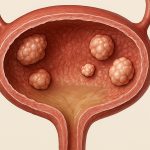Interstitial Cystitis (IC), also known as Bladder Pain Syndrome (BPS), presents a complex challenge for both patients and clinicians. Characterized by chronic pelvic pain, urinary frequency, and urgency, IC significantly impacts quality of life. While the precise etiology remains elusive—likely involving multiple factors including inflammation, nerve sensitization, and epithelial dysfunction—diagnosis relies on excluding other potential causes and evaluating patient symptoms alongside specific tests like cystoscopy. Treatment approaches are similarly multifaceted, ranging from behavioral therapies and dietary modifications to medications aimed at reducing pain and bladder irritation, and in some cases, more invasive interventions. A growing area of interest within the management of IC involves addressing focal lesions or nodules identified on cystoscopic examination, leading to the exploration of techniques such as laser resection.
These bladder wall nodules, often appearing as small, inflamed areas during cystoscopy, aren’t necessarily cancerous but can contribute substantially to a patient’s pain and discomfort. The debate surrounding their clinical significance continues; are they simply manifestations of widespread inflammation or do they represent distinct focal points driving the overall IC syndrome? Increasingly, clinicians lean towards the latter view, particularly when patients report localized pain correlating with nodule location. This has spurred investigation into targeted therapies aimed at removing or reducing these nodules, offering a potential alternative to systemic treatments and addressing the source of discomfort more directly. Laser resection, utilizing various laser technologies, has emerged as a promising option for managing this specific aspect of IC, though it’s crucial to understand its role within a broader treatment plan and the considerations surrounding its application. Further exploration of laser techniques in urology can provide valuable context.
Understanding Laser Resection Techniques
Laser resection involves using focused laser energy to remove or ablate bladder wall nodules. Several types of lasers are employed in urological procedures, each with distinct characteristics influencing their suitability for IC nodule management. Holmium YAG (Ho:YAG) lasers are frequently used due to their precise cutting ability and relatively minimal thermal damage to surrounding tissue—a critical factor given the delicate nature of the bladder wall. CO2 lasers can also be employed, offering excellent ablation capabilities but potentially creating more post-operative scarring if not carefully managed. More recently, fiber optic technology has allowed for increasingly focused and controlled laser delivery, enhancing precision and minimizing collateral damage. The choice of laser depends on factors like nodule size, location, the surgeon’s experience, and available equipment.
The procedure itself is typically performed cystoscopically—meaning a small camera and instruments are inserted through the urethra into the bladder. After identifying the nodules, the laser fiber is positioned directly over the target area. The laser energy then precisely removes or ablates the nodule tissue. Importantly, this isn’t a “cure” for IC; it’s an attempt to address a localized source of pain and potentially improve overall symptom burden. Post-operative care usually involves catheterization for a short period (typically 1-3 days) to allow the bladder to heal and prevent bleeding, along with monitoring for potential complications like infection or hematuria (blood in urine). The aim is to reduce inflammation and provide symptomatic relief while continuing other IC therapies.
Laser resection isn’t without its limitations. It’s generally reserved for patients with well-defined, localized nodules that appear to be contributing significantly to their pain. Patients with diffuse bladder inflammation or widespread disease may not benefit as much from this targeted approach. Furthermore, the procedure carries inherent risks, although these are generally low when performed by experienced surgeons. The effectiveness of laser resection can vary considerably between individuals; some patients experience substantial and long-lasting relief, while others see only modest improvement. This variability underscores the need for careful patient selection and realistic expectations.
Patient Selection Criteria & Preoperative Assessment
Determining which IC patients are suitable candidates for laser resection requires a thorough evaluation process. – First and foremost, detailed cystoscopy is essential. This isn’t just about identifying nodules; it’s about characterizing them – their size, location, appearance (are they inflamed, fibrotic, or ulcerated?), and how closely they correlate with the patient’s pain points. A hydrodistention of the bladder during cystoscopy helps assess overall bladder capacity and identify any other abnormalities beyond the focal lesions. – Secondly, a comprehensive medical history is crucial. This includes understanding the duration and severity of IC symptoms, previous treatments tried (and their effectiveness), and any co-existing conditions that might influence treatment decisions or increase surgical risk.
The patient’s pain map – detailing where they experience discomfort – is paramount. If the nodules don’t align with the reported pain locations, resection may not yield significant benefit. – Thirdly, urodynamic testing can provide valuable information about bladder function and capacity. This helps rule out other causes of urinary symptoms and assess whether laser resection might impact bladder compliance or emptying. – Finally, patients should have realistic expectations. Laser resection is often part of a broader IC management plan; it’s rarely a standalone cure. It’s important to clearly communicate the potential benefits, risks, and limitations of the procedure before proceeding. Understanding bladder wall resection techniques can help in patient education.
Patients with certain conditions may not be ideal candidates for laser resection. These include those with active urinary tract infections (UTIs), significant bleeding disorders, or severe bladder dysfunction. Those who have undergone extensive prior pelvic surgery or radiation therapy may also pose a higher risk during the procedure. Preoperative imaging, such as CT scans or MRI, might be necessary to rule out other pathology and assess the anatomy of the bladder and surrounding structures. Careful patient selection is the cornerstone of successful laser resection for IC nodules.
Postoperative Recovery & Potential Complications
The immediate postoperative period following laser resection typically involves catheterization – usually for 1-3 days—to allow the treated area to heal and prevent bleeding or spasms. Patients are monitored closely for signs of infection, hematuria (blood in urine), and urinary retention. Pain management is a key component of recovery; pain levels will vary depending on the extent of the resection and individual pain tolerance. Over-the-counter analgesics or prescription pain medication may be prescribed as needed. It’s crucial to stay well-hydrated postoperatively, drinking plenty of fluids to help flush the urinary system and promote healing.
Longer-term recovery involves gradually resuming normal activities. Strenuous exercise and heavy lifting should be avoided for several weeks to minimize stress on the bladder. Patients are advised to follow a bladder diary to monitor their urinary symptoms and track any changes. Follow-up cystoscopy is usually scheduled 6-8 weeks after the procedure to assess healing, evaluate the effectiveness of the resection, and identify any recurrent nodules or complications. Regular pelvic floor physical therapy can also be beneficial for strengthening supporting muscles and improving bladder control.
While laser resection is generally considered safe, potential complications can occur. These include: – Hematuria (blood in urine) – often minor and self-limiting, but significant bleeding may require intervention. – Urinary tract infection (UTI) – a common complication following any urological procedure. – Bladder perforation – rare, but potentially serious; requires immediate management. – Urethral stricture – narrowing of the urethra, which can obstruct urine flow. – Recurrence of nodules – even after successful resection, new nodules may develop over time, necessitating repeat procedures. Open communication with your healthcare team is vital and understanding potential complications like gross hematuria in bladder cancer patients is important.
Long-Term Outcomes & Future Directions
The long-term outcomes following laser resection for IC bladder wall nodules are still being investigated. Studies have shown varying degrees of success, with some patients experiencing significant and durable symptom relief while others see only modest improvement. Factors influencing the outcome include nodule characteristics (size, location), patient selection, surgical technique, and adherence to postoperative care instructions. Many clinicians report that laser resection can be particularly effective for patients whose pain is directly correlated with focal lesions, providing a targeted approach to address a specific source of discomfort.
However, it’s important to reiterate that laser resection isn’t a cure for IC. It often forms part of a comprehensive treatment plan that includes behavioral therapies, dietary modifications, medications, pelvic floor physical therapy, and other interventions. The goal is to manage symptoms and improve quality of life—not necessarily eliminate the underlying disease process entirely. Emerging research focuses on refining laser techniques, exploring new energy sources (e.g., holmium laser enucleation of the bladder) and identifying biomarkers that can predict which patients are most likely to benefit from resection.
Future directions in IC management may involve combining laser resection with other therapies, such as intravesical injections of hyaluronic acid or botulinum toxin, to enhance healing and reduce inflammation. Personalized treatment approaches, tailored to individual patient characteristics and disease presentation, are also gaining traction. Ultimately, a deeper understanding of the underlying mechanisms driving IC will be crucial for developing more effective and targeted therapies, including those that address focal lesions like bladder wall nodules with greater precision and long-lasting results. Learning about partial bladder wall resection for non-invasive tumors provides context to treatment options.





















